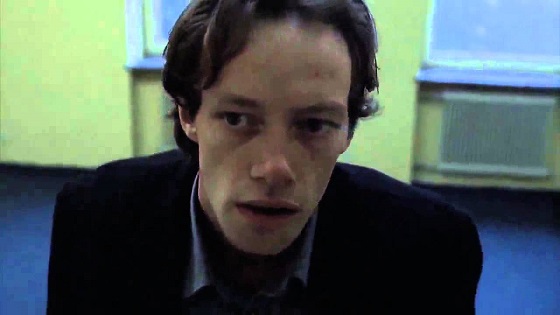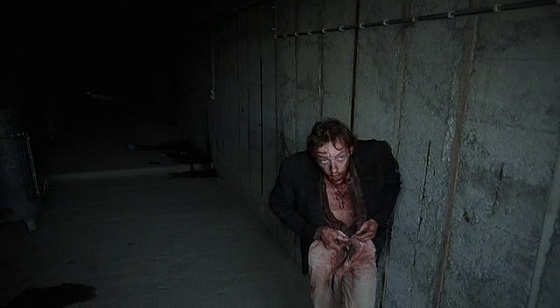Although it has a fairly rich cinematic history, most American filmgoers only know Austria as the birthplace of Arnold Schwarzenegger. With its close proximity to (and shared language with) Germany, what few Austrian films that find their way to America are often mistaken for German productions. The country is not usually thought of as a hotbed of horror, but last year’s dark horse thriller Goodnight Mommy was Austrian, as was Michael Haneke’s 1997 home invasion nightmare Funny Games (which was remade in English ten years later by Haneke himself for American audiences). In 1983, another legendary Austrian horror film was made, the proto-psycho-slasher with the name that means “Fear” in English, Angst.

Angst is the story of a man, known only in the film’s credits as The Psychopath and played by Erwin Leder (Das Boot), who is sent to prison after killing an old woman in cold blood. He is able to convince the authorities that sadism is a mental disorder and, since he is found to be not responsible for his actions by reason of insanity, he is granted parole. Of course, the first thing he does when he gets out of jail is look for more people to kill. He stops and surveys the crowd at a coffee shop, then takes a cab out to the woods and tries to kill the driver. When his attempt is thwarted, he flees into the forest – and comes across a secluded house which is occupied by a vulnerable family. The Psychopath breaks in and plans to torment the family before he kills them, but there may be a few surprises in store for him before he’s done.

Directed by Gerald Kargl from a script that he wrote along with Zbigniew Rybczynski, Angst is the only feature-length horror movie from either filmmaker, although Rybczynski won a Best Animated Short Film Oscar for Tango the same year that Angst was released. Angst’s screenplay is loosely based upon the case of Austrian serial killer Werner Kniesek, but the events of the movie are highly sensationalized to the point of being exploitative. Much of the violence in Angst is gratuitous and shocking, but that’s really the whole point; the film exists for the sole purpose of being brutal and disturbing, an early ancestor of the modern torture-porn movie.

There are a couple of different versions of Angst in circulation. The original 1983 version of the movie was about seven minutes shorter than the uncut edition that can be found today. A French version of the movie, released years after the initial run and retitled as Schizophrenia, had a pre-credits scene re-inserted that showed the crime that sent The Psychopath to prison and also included a lengthy explanation of his psychiatric evaluation. Essentially, the missing footage explained much of the killer’s motives for the rest of the movie, and gives the entire film a bit of meaning. Reportedly, both director Gerald Kargl and leading man Erwin Leder were partial to the version with the exposition excised, but luckily for fans, both versions of the film are relatively easy to find so that they can make their own decision as to which one they prefer.

The visual rampage that The Psychopath goes on is accompanied by voice-over narration that puts the viewer directly inside of the anti-hero’s head. Not only does he walk the audience through his thought process every step of the way as he commits his heinous crimes, but he also gives up little tidbits about his past and childhood, talking about his family life and his upbringing. Although The Psychopath is no protagonist, the other characters in the film are secondary figures, mere bit players in the star’s story – like The Psychopath, none of them are given names, but they are referred to even more generically in the credits, with titles like “Mother” and “Daughter.” The internal monologue serves as almost a justification for the madman’s atrocities, and that makes the ideas behind Angst even more horrifying than its images alone.

The most instantly striking aspect of Angst is its creative cinematography, courtesy of Zbigniew Rybczynski, who also edited the film and, as you may recall, helped write the screenplay. The photography makes it perfectly clear who the central character is, following and floating around The Psychopath, spinning and circling him in a controlled-yet-maniacal way. Sometimes the camera is fastened to him so that his head is the only static image in the shot while the background moves frantically behind him, and sometimes the camera is on a crane or a Steadicam just roaming around him, but the focus is always on The Psychopath in a paranoid, voyeuristic kind of way. Whatever Angst lacks in narrative structure is more than made up for with its inventive style of cinematography.

The soundtrack to Angst was composed by Klaus Schultze, who not only scored horror movies like Barracuda and Next of Kin, but also played drums for ambient electronic groups Tangerine Dream and Ash Ra Tempel. The music for Angst is spooky, melodic, and very new age-y – it basically sounds like what one would imagine a Tangerine Dream horror score would sound like. It also breaks into moments of pure-eighties synth-pop, but that’s just Klaus Schultze having fun. Parts of the Angst score were eventually repurposed into the 1986 Michael Mann film Manhunter (better known as the first screen appearance of Hannibal Lecter), so between that and the Angst soundtrack album that Schultze himself released, the music to Angst is probably more well-known than the movie itself.

For many people, Austria is just the country next door to Germany which gave Hollywood its biggest action hero, but it’s also made its share of movies, and Angst is one of the best.
